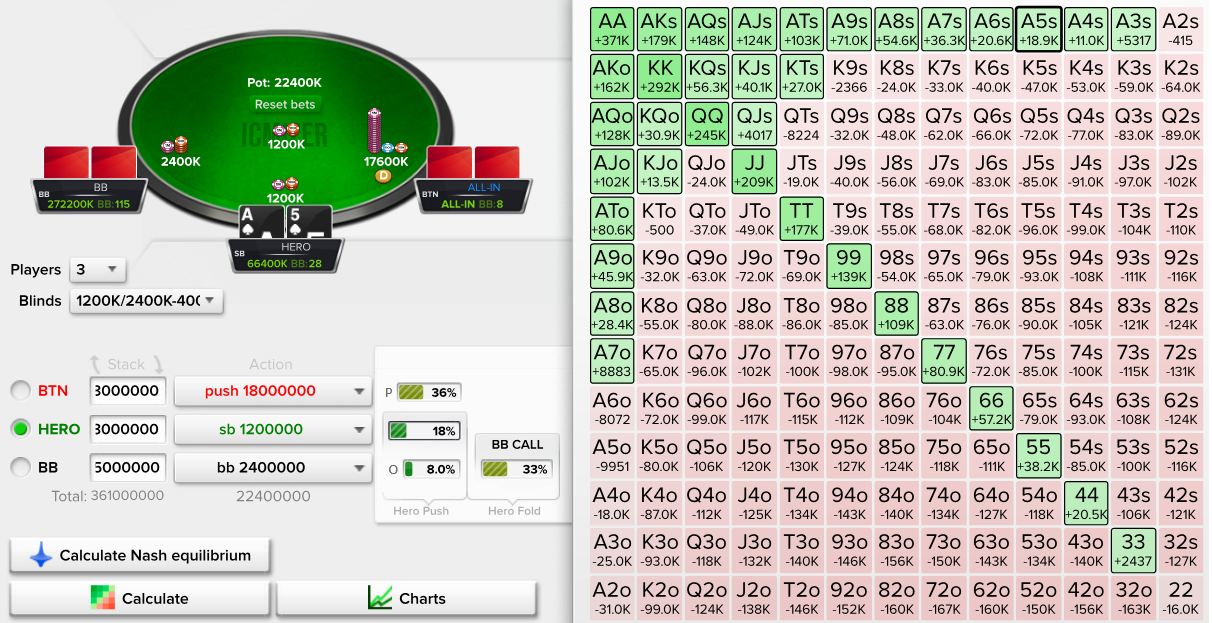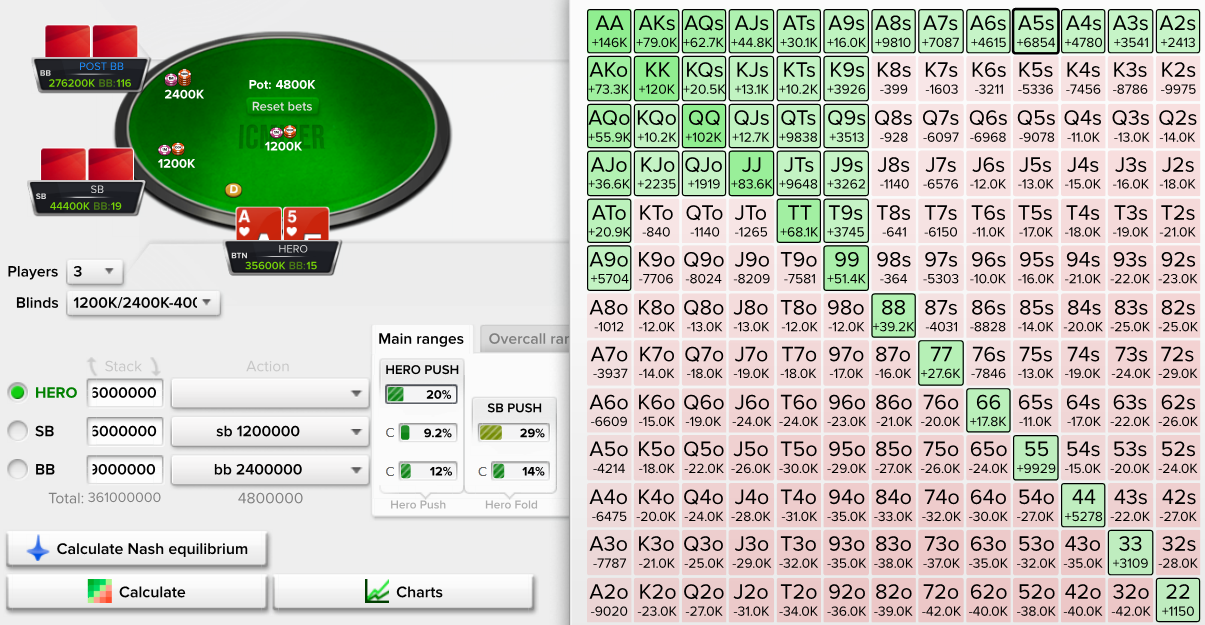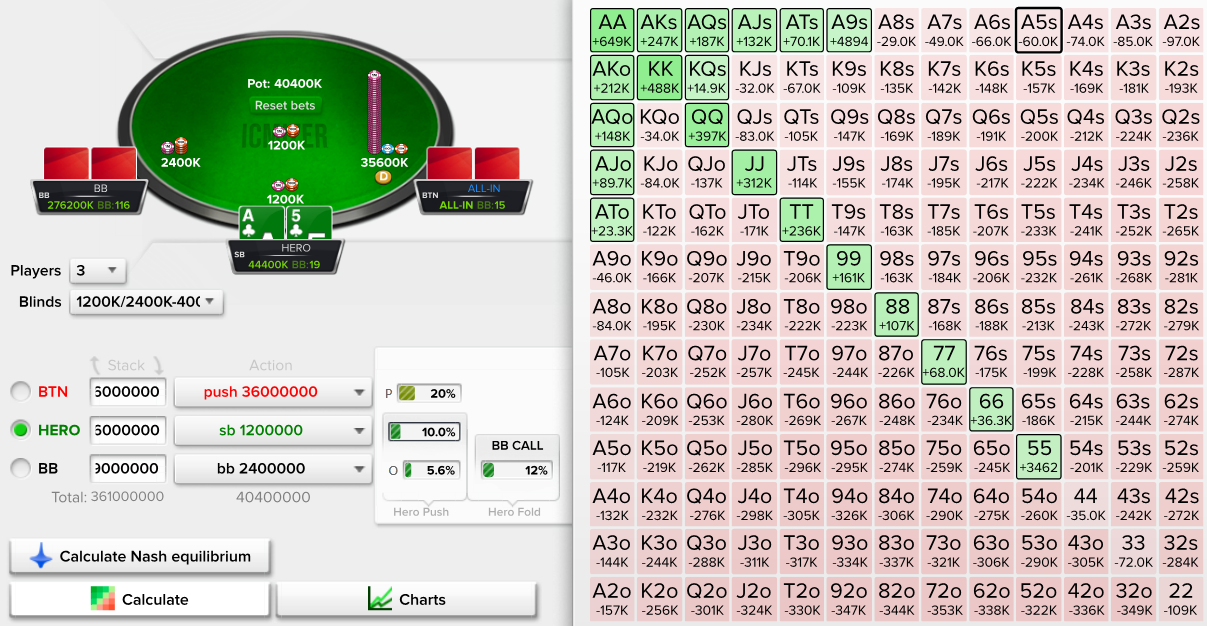 Like most of you, whenever the WSOP being broadcast on PokerGo or ESPN, I was in front of my TV. There was lots of exciting poker and many great plays, as well as some plays that were not so great. In this article, I am going to explain two mistakes that were committed late during the Main Event final table that resulted in one player losing over $166,000 in equity. If you diligently study situations like this, you will be better prepared to make profitable decisions when you are fortunate enough to make a deep run so you don’t spew equity all over the place.
Like most of you, whenever the WSOP being broadcast on PokerGo or ESPN, I was in front of my TV. There was lots of exciting poker and many great plays, as well as some plays that were not so great. In this article, I am going to explain two mistakes that were committed late during the Main Event final table that resulted in one player losing over $166,000 in equity. If you diligently study situations like this, you will be better prepared to make profitable decisions when you are fortunate enough to make a deep run so you don’t spew equity all over the place.
To set the stage, the payouts when there were three players remaining at the final table were:
1st: $8,150,000
2nd: $4,700,000
3rd: $3,500,000
As you can see, the payout jumps are quite significant, which should lead the shorter stacks to avoid calling off for all of more of their chips without being a sizable favorite.
The chip stacks and positions were:
Button: 17.9M Pollak
Small Blind: 68M Ott
Big Blind: 275M Blumstein
In the first hand, with blinds at 1.2M/2.4M-400k, Pollak pushed all-in from the button for 17.9M with Jc-4c. Right off the bat, using the program ICMIZER, you can see that pushing this hand results in an $8,233 loss. To watch me work with ICMIZER on Youtube here, here, here, and here. In the first video, I review a similar all-in spot and in the other three, I test myself against the quiz function. The chart below outlines how much you win or lose with each hand in your range. Navigate to J-4s so see the result. Ignore the A-5s that is selected, as that is just the default hand for some reason.
After Pollak went all-in, Ott decided to call with Ah-2h. While the math isn’t exactly as precise, due to him being nowhere near all-in, you can see that calling is a slightly losing play:
This is an interesting spot because Pollak was clearly pushing wider than he “should” which should lead Ott to call a bit wider than normal. However, given Blumstein has a giant stack in the big blind, I think Ott should actually call a bit tighter than normal because…
Blumstein pushed went all-in with Kc-Tc, resulting in Ott folding away all of his equity (Ouch!). Of course, Ott may flat with his entire range, meaning that he will often be able to easily call Blumstein’s all-in with hands like A-A, 8-8, and A-J, especially if he expects to frequently face a push. However, he could be using perhaps the worst strategy of pushing his best hands and calling with his marginal hands, making him easily exploitable.
In the next hand, where the $166,000 blunder takes place, the stacks and positions were:
Button: 35M Pollak
Small Blind: 46M Ott
Big Blind: 279M Blumstein
With the same 1.2M/2.4M-400k blinds, Pollak went all-in with Qc-Td, another error:
Ott then went all-in with K-9, the $166,000 mistake:
The reason calling is so bad in this situation is because despite looking like a decent hand, K-9 fares quite poorly against any reasonable pushing range. Also notice how Pollak is pushing for 14.5 big blinds, which means that he simply must have something decent. Even if Pollak turned his Q-T face-up, K-9 is not thrilled to call.
After the two all-ins, Blumstein woke up with A-Q and gave it some serious thought before calling. As you can see, calling two all-ins with A-Q is barely profitable (which means that if he thinks he can find better spots in the future, he should likely fold):
Final table math is difficult, but if you spend a lot of time away from the table studying it, you will get a better handle on when you should be pushing, calling, or folding. In general, when you have anout 13 big blinds or fewer, you can push with a somewhat wide range when the action folds to you, but if calling an all-in requires a decent amount of your chips, you need a sizable edge to justify calling. This often results in calling ranges that are much tighter than many amateurs expect.
As a side note, if the players put some sort of value in winning the WSOP Main Event (as opposed to the pure monetary value), then perhaps the somewhat loose calls were not so bad. For example, if in your mind third place and first place pay exactly the same because you view third place money as essentially infinite, then you are essentially playing to win because there is no difference in prize money between first and third. If you adjust the settings on IZMIZER to a winner take all setting, you will see that calling with the K-9 becomes much more reasonable (but still a losing play). That said, most of us play poker to win money. If you find yourself thinking “I am playing to win the tournament” and you then act on that thought under all circumstances, you might as well light your money on fire.
 If you enjoyed this blog post, you will love my exclusive 4-hour long webinar where I reviewed all of the relevant hands, including all the great plays and horrible mistakes, from the 2017 WSOP Main Event final table. You can find the full details on how you can get access to this exclusive webinar here. Check it out and let me know what you think!
If you enjoyed this blog post, you will love my exclusive 4-hour long webinar where I reviewed all of the relevant hands, including all the great plays and horrible mistakes, from the 2017 WSOP Main Event final table. You can find the full details on how you can get access to this exclusive webinar here. Check it out and let me know what you think!






In the second hand that you describe above, you reference Pollack for both the K-9 hand and Q-10 hand. Obviously one of these hands should be Ott.
Great content as always, Jonathan. Thanks!
Thanks for pointing it out. I made the edit. If you see any other issues, please let me know!
I think Ah2H would have played better as a shove.
As ICMizer states, pushing loses equity (assuming winning the tournament is irrelevant, which often is not the case in the WSOP Main Event).
Why is A5 showing as hand.
It should change when you enter hand.
I didn’t enter a hand. It shows how to play my entire range, not just one hand.